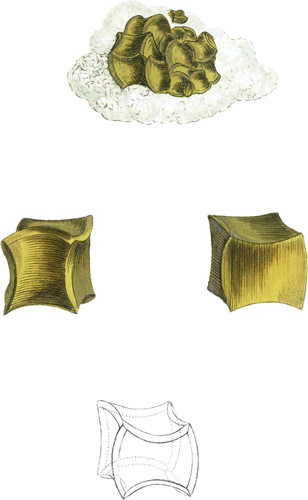 Enlarge
Enlarge
British Mineralogy
Iron Pyrites
These constructions in crystallography have hardly been enough noticed: indeed the laws of aggregation leave much room for endless variety, which perhaps militates more than anything else against the identifying substances by their crystals, especially, as in the present instance, when the substance does not admit of the primitive fracture being observed, which is so easily understood and demonstrated in the rare Galæna, tab. 131. The alternating curves have a certain novelty, and I think a peculiar elegance in this specimen, and when we see several crystals huddled together, confusedly and all resembling each other, it is really enough to excite the admiration of every enquirer, while it must certainly very much attract the attention of the geometrician.
The Pearlspar in general is curiously curved, and tab. 443 represents one of its extremes, showing the six lateral solid angles of the rhomb, alternating in their curvature*; and this is an example of the eight angles of a cube. The mlddlt right hand figure, which is taken from another specimen, shows t lie more simple commencement of the curvature. Some crystals are a little more curved than others; but all have the bevelling at the opposite and alternating edges; see the left hand figures. This specimen came from the neighbourhood of Tavistock, and was presented to me by Miss Elizabeth Pocock, whose attention to the conchology of Britain is well known. It is yellower than tab. 29, but probably differs very little as to its contents. It rests upon small equiaxed crystals of Carbonate of Lime.
- * Many of these varieties, which were formerly considered as Carbonates of Lime, are by the penetration of some of our ingenious friends, discovered to be Carbonates of Iron, of which more will be said hereafter.

